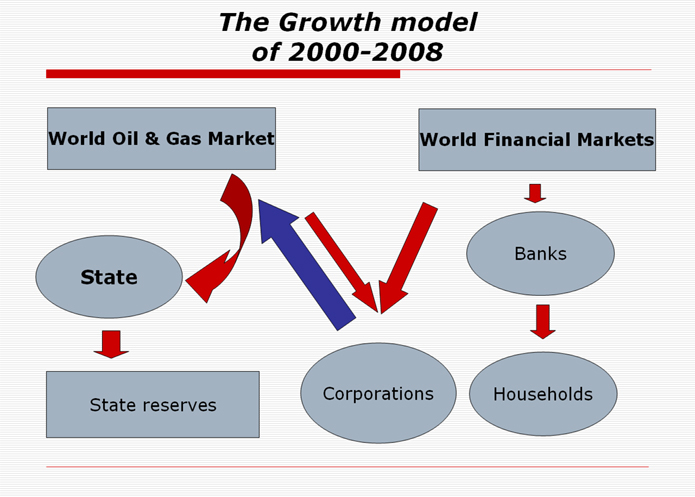|
Russian Economic Development: Before and
After the Crisis of 2008
Summary
of the presentation given on December 22, 2008, by Boris V. Kuznetsov

The Russian
economy has been demonstrating rather high, if not spectacular,
economic growth for the past 8 years. This growth is commonly
attributed exclusively to high oil prices and high export revenues. So,
the crisis of 2008 in Russia is often looked on just as a consequence
of falling oil prices. While to a great extent this may be true, such
an approach cannot fully explain the scale or the speed of impact the
world crisis of 2008 had on the Russian economy. To better understand
the internal mechanisms of the crisis processes, it is important to
look more closely at the model of growth that evolved in Russia in
2001-2007 and on fundamental problems of the Russian economy and of the
Russian manufacturing industry, in particular.
While export revenues grew very quick due to increasing oil prices as
well as the prices for other raw materials and primary goods (metals,
in particular), they were not translated into high investments until
2006, but mostly resulted in the growth of private consumption. Part of
the consumption demand was for services and non-tradable goods and had
a stimulating effect on the economic growth in those sectors, but
growing demand for other goods had limited influence on the economy.
Russian manufacturing was unable to satisfy the growing domestic
demand, both because of the relatively high costs of production and the
inability to provide quality goods at competitive prices . Capital
inflow largely consisted of portfolio financial investments coupled
with export revenues which put additional pressure on the exchange rate
and led to high growth rates of prices, in particular on the stock
market and in the real estate market. FDI into Russia mostly were
concentrated not in manufacturing but in the extraction industries and
had a modest impact on production and efficiency growth. So, extremely
high rates of import growth (in 2007 import growth rates were 9 times
higher than export growth rates) became an important feature of the
Russian growth model.
Russian economic and monetary authorities had a difficult task of
trying to prevent a sharp appreciation in the currency which threatened
to make most of the manufacturing industry/sector uncompetitive on one
hand and fighting high inflation on the other hand. This contradictory
and inconsistent policy resulted in high foreign reserves of the
Central Bank and in high interest rates on the domestic financial
markets. The high cost of finance to some extent was facilitated by a
large accumulation of oil revenues in the state reserve funds (more
than $150 billion USD at the end of 2008). Due to financial resources
being too expensive inside the country, large Russian corporations and
banks sought short-term loans from the world financial markets that
were at that time providing extremely cheap loans because of excessive
liquidity. Thus, the Russian growth model in 2002-2008 was based on the
state accumulating foreign reserves and simultaneously huge growth of
corporate debts which increased to about $500 billon USD.
Thus, the crash of world financial markets in 2008 immediately put both
the banking sector and the corporate sector in a very dangerous
position, making interference from the government and Central Bank
necessary to stabilize the situation. It has very little to do with
decreases in oil prices, though the problems were highlighted by the
drop in export revenues and a subsequent drop in the international
ratings of Russian corporations and national economy in general, which
made getting loans on the world markets very expensive and near
impossible to get.
Although those consequences of the crisis are more or less successfully
dealt with by the use of state reserve funds to substitute short-term
foreign loans, much more serious and strategic decisions are needed to
fight serious economic problems, caused by the falling prices of
Russian exports. The most important and complicated task for the
Russian government is to try to change the existing model of economic
growth, which has been based on using relatively cheap financing from
the world financial markets to invest mostly into such domestically
oriented industries as construction and real estate, retail trade and
services. The current crisis, while having evident negative
consequences in terms of industrial output decline and unemployment
growth, may have a positive impact on the Russian economy by
facilitating delayed structural and institutional reforms and by making
the Russian industry more efficient and competitive. Just nationalizing
struggling corporations and increasing protectionist policies is not an
option.
Dr. Kuznetsov is a Senior Researcher at the State University - Higher
School of Economics and Chief Researcher at the Interdepartmental
Analytical Center in Moscow. He specializes in the field of Industrial
policy and research of Russian industrial firms’ behavior. He is the
author of a number of publications on industrial development in Russia.
Recent publications include “Russian Industry at the stage of economic
Growth” (Gonchar K and Kuznetsov B. eds.), HSE, “Vershina” Publishing
house. Moscow. 2008; a chapter on the productivity of Russian
manufacturing (with Mark Schaffer) in “Can Russia Compete? Enhancing
Productivity and Innovation in a Globalizing World” (Raj M. Desai and
Itzhak Goldberg eds.). Brookings Institution Press. 2008
*The views expressed in the essay belong
solely to the author and do not represent the official position of any
organizations to which the author is permanently or was temporarily
affiliated.
[index]
|

